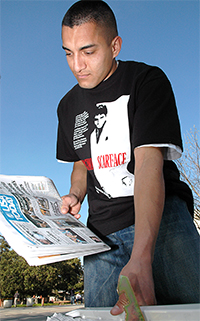AS readership program popular
Fifth in Our Series About Fresno State's Student Government
By AMY ROBERTS
Students are showing interest in the readership program sponsored by
the Associated Students, especially after the addition of The New York
Times to the existing newspapers: The Fresno Bee and USA Today.
The readership program was introduced last year by Associated Students
to provide students with free newspapers on campus and on Feb. 10, the
Senate voted unanimously to add The New York Times to the racks. Distribution
started March 7.
| 
Business major Joseph Calderon said he picks the papers from the
dispensers because they’re free. Photo by Joseph
Hollak |
Associated Students vice president of finance Jennifer Reimer said the
funding for The New York Times came from the new programs line item of
the Associated Students operating budget.
The paper will be available for the rest of the semester with Associated
Students paying for four weeks and The New York Times providing the papers
free of charge during the last four weeks of the semester.
Reimer said she is tentatively budgeting $1,600 for the 200 papers delivered
during the 19 days classes are in session between March 7 and April 8.
Temporary stands have been placed near the existing ones to accommodate
the papers.
An informal survey of students picking up papers found they like having
newspapers available on campus.
“I love it,” Theresa Stepp said. “It makes it easier
to access newspapers because I’m a poor student.”
Starting with a budget of $4,600 to fund last year’s inaugural semester
of the readership program, Neil Gibson, last year’s student body
president, said in his year-end report that the program was added to “increase
student access to national and global news.”
Gibson said the program was a success after reviewing the daily drop-off
of USA Today papers.
“All 210 newspapers normally run out by 10 a.m., indicating a successful
response,” Gibson said.
The actual cost of the newspapers during Gibson’s tenure was less
than $4,000. The difference between the budgeted amount and lower actual
cost indicates the papers not pickedup were not billed to the Associated
Students account.
The 2004-05 approved budget allocated $18,000 to the readership program
and expanded it to include delivery of 400 copies of USA Today and 500
copies of The Fresno Bee distributed among six locations Monday through
Friday.
“Assuming that all of the budgeted $18,000 is spent and there are
100 days of instruction in the school year, the cost per day is $180,”
Reimer said.
Reimer said that amount divided by 20,000 students equals less than a
penny per student per day. But the final cost of the program should be
less per student because an average of 275 papers are returned each day.
Another change to the program this year is the use of keycard-accessible
distribution boxes that students can open free of charge. The decision
to change from open to locked distribution stands came after a student
government survey observed non-students taking papers.
“To deal with this issue, the dispensers were changed,” Reimer
said. “Now a student ID card must be swiped for the dispenser to
be opened. This seems to have done a sufficient job dealing with the problem.”
But students have complained about small annoyances in getting newspapers
from the dispensers.
Some said it was a hassle digging out their ID cards from the backpacks
and purses. Others said they failed to get the paper because they forgot
to bring their cards to school, and some said they’ve experienced
mechanical problems.
After inserting her card unsuccessfully three times, a frustrated Christina
Tyler allowed another student to open the machine for her.
“I didn’t wait long enough for the little light to go on,”
said the senior pre-nursing student.
Besides taking into consideration student comments, another way to evaluate
Fresno State’s readership program is looking at schools that have
used it longer.
Penn State, which has the longest-running collegiate readership program
in the country, started in 1997. According to USA Today’s information
literature, the newspaper’s program is now found on more than 200
campuses nationwide.
With about twice the student body of Fresno State, Penn State’s
budget for the readership program stands at $400,000 and was funded after
adding $5 per semester to student fees. Papers are dispensed from 32 swipe
card dispenser racks containing The New York Times, The Centre Daily Times,
USA Today and 19 smaller regional papers.
During the first week of February, almost 38,000 of the three largest
papers were delivered and slightly more than 9,000 were returned at Penn
State, said Gerry Lynn Hamilton, general manager of Penn State student
newspaper, The Daily Collegian.
“These figures represent a fairly typical week,” Hamilton
said.
He said the readership program has hurt the student newspaper. He specifically
cited the loss of advertising dollars, a lower circulation, and fewer
readers picking up the paper. While The Daily Collegian has taken steps
to counter these problems, Hamilton said it’s an ongoing process
to improve the student paper.
A secondary effect of having so many papers on campus initially resulted
in a lot more trash piling up, Hamilton said.
After experiencing a glut of newsprint and the cost of cleaning it up,
a recycling program was started last year generates a total yearly return
of $10,226. Matching contributions from the three most widely circulated
papers meant more than $20,000 went into Penn State’s general scholarship
fund, according to information found on the school’s readership
program Web site.
But the situation is different at Fresno State.
With only 200 copies, 10 students would have to share one copy to accommodate
10 percent of Fresno State’s enrollment. To stretch the limited
supply, Reimer suggests students share them.
“And it reduces waste if multiple people read a copy,” Reimer
said.
|
